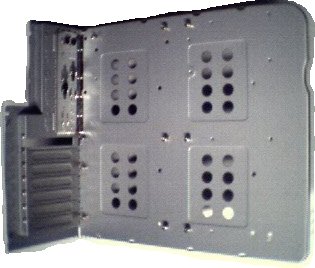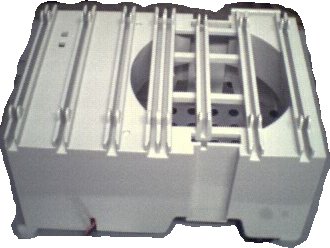The InWin Q500N
Last millennium, I took a closer look at the
Q500Nís little brother, the A500.
While the A500 is just dandy for 99% of all users, what about the power
user? You know, these insane overclockers that runs no less than ten fans,
three 50 watt peltiers, five hard drives, and four CD-ROMís. What do they
need for a case? Then again, maybe they are a case. ;-)
Specifications
This is a full tower case, capable
of handling AT, ATX or Lpx motherboards. Externally, it sports five 5-1/4" slots
and one 3-1/2" slot. Internally, it has five more 3-1/2" slots. Including the
bottom mounted feet, the dimensions are H= 24-1/2", W= 7-7/8", D= 17-1/16". When
the feet are extended, the width increases to 14". Shipping weight is 34lbs (17kg)
and dry weight (with the InWin 235 watt power supply) is 30lbs (14kg). In addition
to the standard ATX power supply mounts, two additional 3" (4" diagonal) fans
can be mounted inside.
Impressions
|
Specifications
|
The
Case
|
- Dimensions: 600
mm * 200 mm * 432 mm (H*W*D) -- 23 5/8" * 7 7/8" * 17 1/16"
- Disk space: 5
* 5.25", 1 * 3.5", (internal:5 * 3.5")
- Weight: N.W.
12.60 kg (27.60 lb), G.W. 13.60 kg (30.00 lb)
- Mainboard: Baby
- AT style, ATX FORM FACTOR, Full Size AT sytle
- Security: Padlock
Option
- Meet CE, FCC
Class B
|
|
As with most full tower cases, the power supply
sits above the motherboard horizontally, so any type of radical heatsink/fan
combo can be crammed in without trouble.
Itís just plain convenient to have total access to everything (IDE cables,
RAM, fan headers, etc.) on any board you decide to install.
Fold out feet arenít anything
new but I wanted to investigate why they spread out, eagle like, a full fourteen
inches. With the feet (two pairs, front & rear) collapsed, the case is
somewhat unstable. No, that doesnít mean that your C366 wonít crank to 550,
rather that itís slightly tipsy. A two-foot tall case isnít exactly top heavy
but compared to the squatty A500 mid tower design, it does have the opportunity
to fall over if bumped hard enough. Put the feet in full fly mode and youíd
have to tackle the Q500N to knock it down.
Installation
is typical InWin slide-out tray style. After locating all the copper stand-offs
and corresponding screws, not only does your board affix to the tray but all the
relevant add-in cards plug in as well. If you assemble several systems per day,
this feature can greatly enhance building quality and quantity. When youíre ready,
just shove the entire conglomeration into the case and lock it into place with
a screw.
Another feature, which could be good or bad,
is the location of the exterior 3-1/2" slot at the very top of the unit.
I personally like it way up there because when itís on the floor, the floppy
(I still use one once a week or so) is within arms length. Of course, with
a case two feet tall, anything in the first 3 slots is within arms length.
General construction quality is excellent, as with all the InWin cases Iíve
encountered. No wafer thin sheet metal here; only the good thick stuff. To
that end, also in traditional InWin style, all the sharp edges are smoothed
out. I canít emphasize too strongly that even if you donít build systems for
the public, metal cuts are the pits.
The PowerMan 235 Watt And 300 Watt Supplies
(from the InWin
A500 Review)
If you opt for either one of these units, you
wonít be disappointed. The 300 watt model is so sturdy that AMD
has authorized its use with power hungry Athlon processors. The 235 watt model
(FSP235-60GT) looks like a typical ATX supply in that it has a low voltage
standby switch and a 3" fan. Whatís unusual, and another reason why I
like it so well, is itís choice of power connectors. There are four branches
(bundles) of long connector wires hanging out of the unit. The first one is
the ATX connector, nothing extraordinary about that. Branch #2 has 2 full
size and 1 small plugs on it. Branch #3 has 2 large plugs, and branch #4 has
1 large and 1 small plug. In total, this adds up to 5 large and 2 small plugs
to distribute the power around the peripherals. Thereís plenty of plugs left
for extra case fans, video card fans, and of course, the obligatory Plextor
Combo. I hate those fiddly, unreliable splitters
that so many systems have because the power supply lacks all the plugs necessary.
The 300 watt PowerMan (model FSP300-60GT) is
quite the special piece. It simply reeks of quality and reliability
when you first set eyes on it. The ATX connector is so long that you could
plug it into a motherboard thatís across the room (itís about 18 inches).
Branch #1 is the ATX connector. Branches #2 and #3 have 2 large and 0 small
plugs each. Branches #4 and #5 have 1 large and 1 small plugs each. The remaining
branch is Ĺ of an AT power connector. In total, this adds up to 6 large and 2 small
plugs, one more additional large plug than the 235 watt version, but split
up differently.
 |
 |
 |
 |
| Inside
Tray |
Inside
board |
Fan
Adapter |
Back
View |
Final Musings
With the 235 watt PowerMan power supply, this
rig sells for about $61, which is somewhat cheaper than expected. However,
InWin has a good reputation for delivering a little more than expected. A
case of this stature isnít for everyone. Servers, overclockers and broadly
speaking "high" Enders will appreciate all that the Q500N has to
offer. Considering the price and the ability to obtain the Q500N with other
power supplies (shop around), the Bill-O-Meter flies almost off the recommended
scale. A very well built solid performer.
William
Yaple
00/02/22